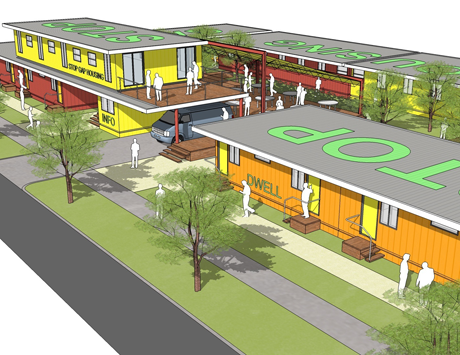
A plan to house Vancouver's homeless is taking shape on the drawing board of a local architect. It calls for the rapid erection of temporary villages assembled from the same type of modular units that mining companies provide for remote workers.
"Stop Gap Housing" is what architect Gregory Henriquez calls it.
"All of us in this community have long been advocates for permanent housing," he said. "But we've gotten to the point where the numbers of homeless are so staggering that I'm left wondering if we will ever catch up doing it that way. I don't think we can. I think there has to be a stop-gap measure. And that's what this is."
Henriquez, whose Woodward's includes 200 units of social housing built to last hundreds of years, stressed that Stop Gap Housing would never replace permanent homes.
"It's portable dwellings. It's not meant to be a permanent fixture on the landscape. But it could serve for several years until we complete the construction of permanent housing," he said. "I think it's better than leaving people homeless."
It's also cheaper. Numerous studies suggest that this sort of housing would save B.C. taxpayers hundreds of millions of dollars a year in police, ambulance, and health expenses.
And if built quickly, the modular housing plan even holds the potential to transform the 2010 Winter Games from an international embarrassment -- during which the world would discover that British Columbia built multi-million-dollar condos for 5,000 Olympic athletes while doing nothing to house its legion of more than 10,000 homeless -- into a showcase of Canadian compassion.
Colourful villages
Remote resource extraction companies have been using these modules to create spartan camps for decades.
"They use these all over the Athabaska tar sands," Henriquez said. "They call it workforce housing."
Henriquez took plans from Britco Structures, which operates plants in Agassiz and Penticton, and showed them to managers from the Portland Hotel Society, which rents to hundreds of the Downtown Eastside's hardest-to-house individuals.
The Portland team suggested that individual units -- with ensuite bathrooms and fronts that open directly to the outdoors -- would be more acceptable to individuals not accustomed to coping with neighbors, as well as to those reluctant to give up pets or bicycles.
Henriquez drew up plans for a motel-like village, with 48 suites clustered around a central courtyard. The colourful compound includes a managers' office, a covered patio, and a second storey meeting room all within a typical 120-by-200-foot city lot.
"The hard part is to make it pretty and nice. But we can do that. We're good at that stuff," Henriquez said. "You paint it some bright colors. You make it as festive as you can. And you house people with dignity."
Developer and former city council candidate Michael Geller, who is working on a similar plan, observed that some of the most tricked-out buildings in the city -- the presentation centres that firms such as Concord Pacific erect to showcase their yet-to-be-built condo towers -- are in fact modular structures.
"We're talking about using corrugated metal painted either in solid colours or with photo murals," Geller said. "These villages might wind up looking at lot like Granville Island."
Speed is beauty
"The speed at which we can accomplish this is the essence of its beauty," Henriquez said.
Indeed, the crux of Vancouver's exploding homelessness problem is as follows: social and economic dislocation is rendering British Columbians homeless much faster than BC Housing can build homes for them.
"The big issue has to do with permitting," Henriquez said. "For a normal social housing building, you might need rezoning, then you need a development permit, then a building permit. That takes years."
But Stop Gap Homes would rest on wooden blocking, not permanent foundations.
"These can all be done through temporary permitting," Henriquez said. "It's a 12-month permit that can be renewed."
Modular construction would shave a couple more years off construction time.
"We've talked to Britco. They have excess capacity because a lot of the oil sands stuff has been cancelled. They could build hundreds of these things within months," Henriquez said.
(And Britco is a B.C. company, with large factories in Agassiz and Penticton. Competitor Shelter Industries is based in Langley. A multi-million dollar order placed with either company would represent a timely stimulus for B.C.'s struggling forest products industry.)
Saving tax dollars
Henriquez is preparing a plan to erect 1,000 units of Stop Gap Housing on eight city sites within less than a year.
If combined with the reopening of almost 500 shuttered hotel rooms recently identified by the Carnegie Community Action Project, the Stop Gap plan would provide enough homes to house nearly all of the 1,547 individuals found in Vancouver during the spring 2008 homeless count, and leave hundreds of shelter beds left over for the newcomers expected to arrive as the 2010 Games approach.
And the cost of building those 1,000 units would be less than what the city and province are currently paying to administer to those same people on the street.
B.C. taxpayers currently spend an average of $55,000 per year in health, corrections and social services for each of the estimated 11,750 homeless people in the province, according to a 2008 study by SFU's Centre for Applied Research in Mental Health and Addiction. That's $644 million a year to maintain homelessness.
Modular homes such as Stop Gap Housing could be built for less than $40,000 per unit, according to Geller's estimates. (That figure includes all furniture and fixtures, but does not include the price of land, which would be provided by the city, or the price of management, which might be funded by the province.)
The SFU study, like many before it, found that the public cost of caring for housed individuals is less than half the cost of caring for the street homeless -- and can drop to zero once addictions or mental illnesses are treated.
So the likelihood is that in addition to saving lives, Stop Gap Housing would begin saving city and provincial tax dollars within just a few years of installation.
VANOC at work on a similar project
The idea makes so much sense that VANOC is already spending about $18 million to create 320 modular housing units as workforce housing at the Olympic Village in Whistler.
Once the games are over, the province plans to spend another $22 million or so to convert those units to 156 affordable housing units and relocate them in six communities across the province: Chetwynd, Chilliwack, Enderby, Saanich, Sechelt and Surrey.
At least one of those relocation projects will bear a remarkable resemblance to the Stop Gap Housing plan. In Surrey, approximately 48 of the Britco units will be reconfigured on a city-owned site as housing for people who are homeless or at risk of homelessness.
The total cost of the VANOC project, which is co-sponsored by Britco and RONA, is budgeted at $43.6 million.
Henriquez, in partnership with the Portland Hotel Society, is in preliminary discussions with a leading local developer to bring the Stop Gap proposal before the city. He figures the total cost of 1,000 units will also run somewhere in the ballpark of $40 million.
And he hopes that Vancouver's business leaders will join with socially responsible Olympic sponsors as well as the federal and provincial governments in ponying up that cost.
"We could do a thousand units in a year. Easily. But everyone has to say, go now," Henriquez said, snapping his fingers. "We need leaders with real courage."
'We can end homelessness this way'
Mayor Gregor Robertson, who was elected on a promise to end street homeless in Vancouver, met with Henriquez about the Stop Gap idea early this week.
"I'm definitely interested," Robertson told The Tyee.
"There are some major challenges, with finding the land and the funding being the two big ones. But I think that with both a provincial election and the Olympics coming, you're going to see a growing urgency among senior levels of government to get housing built quickly, and this could be on the table," Robertson told The Tyee.
"I'd like to get staff involved in this and get council on board before we drive it forward," he added.
"I'm not opposed to using city-owned land if we have support from the province and/or the federal government," Robertson said. "I also want to make it clear that permanent housing is the only real solution -- we can't have temporary housing turn into the permanent answer."
Henriquez agreed.
"This isn't somewhere we wanted to go," he said. "But I think there are not a lot of choices. If we don't act quickly, more people will die. And this is within our means... We can end homelessness this way."
Related Tyee stories:
- Up to 15,500 Homeless: Report
Tally of BC homeless by health profs far higher than housing minister's. - How Homeless Housing Got Stalled
And why this project will take a decade to get built. - Homeless Hell Hole Below Science World
'Worst' of many 'really rough spots' says city's outreach worker.
Read more: 2010 Olympics, Housing















Tyee Commenting Guidelines
Comments that violate guidelines risk being deleted, and violations may result in a temporary or permanent user ban. Maintain the spirit of good conversation to stay in the discussion.
*Please note The Tyee is not a forum for spreading misinformation about COVID-19, denying its existence or minimizing its risk to public health.
Do:
Do not: